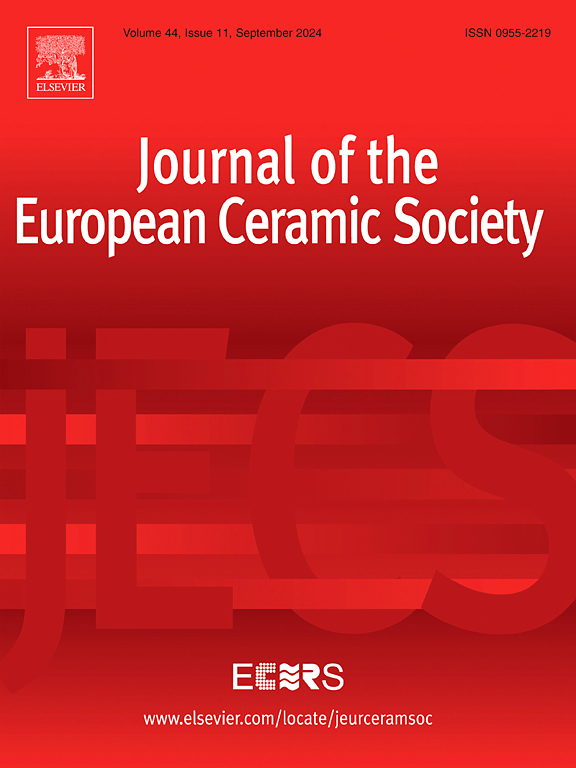高熵铝酸盐尖晶石氧化物:通往先进功能材料的途径
IF 6.2
2区 材料科学
Q1 MATERIALS SCIENCE, CERAMICS
Journal of The European Ceramic Society
Pub Date : 2025-05-30
DOI:10.1016/j.jeurceramsoc.2025.117582
引用次数: 0
摘要
本文研究了三种不同成分(Co,Mn,Ni,Zn,Cu)Al2O4、(Co,Mn,Ni,Zn)Al2O4和(Co,Mn,Ni,Mg)Al2O4的高熵铝酸盐尖晶石氧化物(Al-HESOs)的合成和表征。采用室温自传播法合成,火花等离子烧结致密化,成功地获得了相对密度高达97% %的单相Al-HESOs。结构,机械和热性能进行了全面分析,证明了显著的可调性。值得注意的是,Cu2+的加入大大降低了杨氏模量(3.8 GPa),同时保持了高硬度(9.9 GPa)和低热扩散率(0.78 mm²s⁻¹在室温下- 0.63 mm²s⁻¹在600°C下),将(Co,Mn,Ni,Zn,Cu)Al₂O₄作为应变适应热阻隔涂层的有希望的候选者。这些发现为Al-HESOs的合成和致密化提供了新的途径,并为其在先进能源、传感和热管理技术中的应用奠定了基础。本文章由计算机程序翻译,如有差异,请以英文原文为准。
High-entropy aluminate spinel oxides: A pathway to advanced functional materials
This study investigates the synthesis and characterization of high-entropy aluminate spinel oxides (Al-HESOs) with three distinct compositions: (Co,Mn,Ni,Zn,Cu)Al2O4, (Co,Mn,Ni,Zn)Al2O4, and (Co,Mn,Ni,Mg)Al2O4. Using the self-propagating room temperature method for synthesis and spark plasma sintering for densification, single-phased Al-HESOs with relative densities up to 97 % were successfully obtained. Structural, mechanical, and thermal properties were comprehensively analysed, demonstrating significant tunability. Notably, the inclusion of Cu2+ drastically reduced the Young's modulus (3.8 GPa) while maintaining high hardness (9.9 GPa) and low thermal diffusivity (0.78 mm² s⁻¹ at room temperature – 0.63 mm² s⁻¹ at 600 °C), positioning (Co,Mn,Ni,Zn,Cu)Al₂O₄ as a promising candidate for strain-compliant thermal barrier coatings. These findings establish a novel synthesis and densification route for Al-HESOs and their potential for applications in advanced energy, sensing, and thermal management technologies.
求助全文
通过发布文献求助,成功后即可免费获取论文全文。
去求助
来源期刊

Journal of The European Ceramic Society
工程技术-材料科学:硅酸盐
CiteScore
10.70
自引率
12.30%
发文量
863
审稿时长
35 days
期刊介绍:
The Journal of the European Ceramic Society publishes the results of original research and reviews relating to ceramic materials. Papers of either an experimental or theoretical character will be welcomed on a fully international basis. The emphasis is on novel generic science concerning the relationships between processing, microstructure and properties of polycrystalline ceramics consolidated at high temperature. Papers may relate to any of the conventional categories of ceramic: structural, functional, traditional or composite. The central objective is to sustain a high standard of research quality by means of appropriate reviewing procedures.
 求助内容:
求助内容: 应助结果提醒方式:
应助结果提醒方式:


